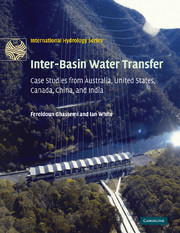Book contents
- Frontmatter
- Contents
- Foreword
- Overview and Scope
- Acknowledgements
- List of Abbreviations
- Part I The Challenges
- Part II Inter-basin Water Transfer in Australia
- Part III Inter-basin Water Transfer in Other Selected Countries
- 11 Inter-basin water transfer in the United States of America
- 12 Inter-basin water transfer in Canada
- 13 Inter-basin water transfer in China
- 14 India: The National River-Linking Project
- 15 Inter-basin water transfer, successes, failures and the future
- Part IV Appendices
- Glossary
- Index
- References
11 - Inter-basin water transfer in the United States of America
Published online by Cambridge University Press: 05 November 2009
- Frontmatter
- Contents
- Foreword
- Overview and Scope
- Acknowledgements
- List of Abbreviations
- Part I The Challenges
- Part II Inter-basin Water Transfer in Australia
- Part III Inter-basin Water Transfer in Other Selected Countries
- 11 Inter-basin water transfer in the United States of America
- 12 Inter-basin water transfer in Canada
- 13 Inter-basin water transfer in China
- 14 India: The National River-Linking Project
- 15 Inter-basin water transfer, successes, failures and the future
- Part IV Appendices
- Glossary
- Index
- References
Summary
OVERVIEW OF GEOGRAPHY, POPULATION, LAND AND WATER
GEOGRAPHY
The Unites States of America covers a total area of 9 372 570 km2. To this, Alaska contributes 1 530 690 km2 and Hawaii 16 760 km2. Other areas outside the 48 contiguous States include Puerto Rico, American Samoa, Guam and the Virgin Islands. The east–west and north–south dimensions of the country are approximately 4517 km and 2572 km respectively. The United States has diverse physiographic features with broad plains, plateaus and mountain areas (Figure 11.1). The country's surface elevation ranges from 86 m below sea level in Death Valley, California to 4419 m at Mount Whitney, California, and 6198 m at Mount McKinley, Alaska (U.S. Census Bureau, 2003, Table 363). The approximate mean elevation of the country is 763 m, and its main physiographic regions are (Murphy, 1996):
The Coastal Plain is located along the Atlantic Ocean and the Gulf of Mexico. Midway along the Coastal Plain, the Florida Peninsula separates the waters of the Atlantic from those of the Gulf of Mexico. West of the Peninsula, the Coastal Plain is wide, but towards the north-east it gradually narrows and in the neighbourhood of New York City the plain comes to an end.
The Appalachian Highlands make up the dominant relief feature of the eastern United States, but they have relatively low elevation. Mount Mitchell in North Carolina, with an elevation of 2038 m, is the highest peak in eastern North America. The Appalachian Highlands form an effective watershed between the streams that flow to the Atlantic Ocean and those that flow westward to the Mississippi River.
[…]
- Type
- Chapter
- Information
- Inter-Basin Water TransferCase Studies from Australia, United States, Canada, China and India, pp. 201 - 260Publisher: Cambridge University PressPrint publication year: 2007



